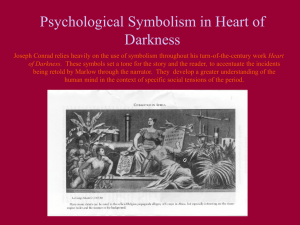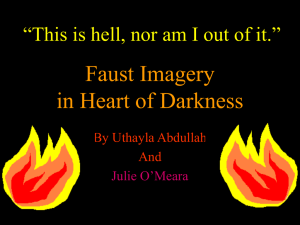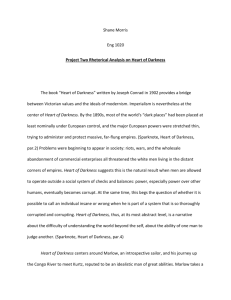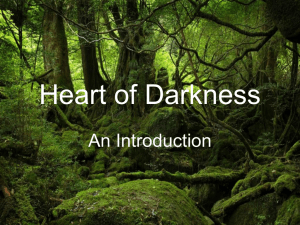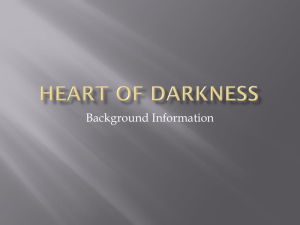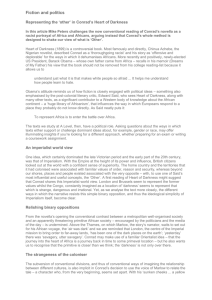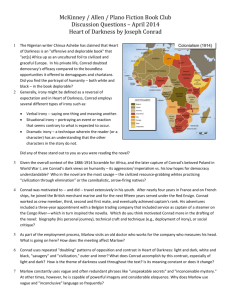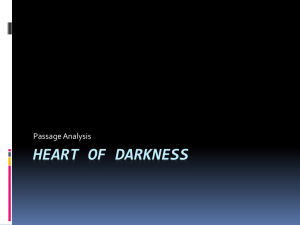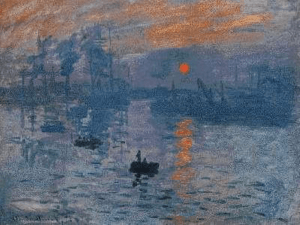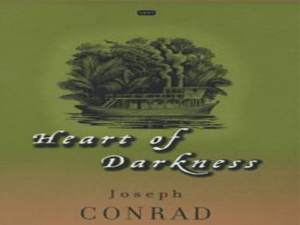Themes, Motifs & Symbols
advertisement
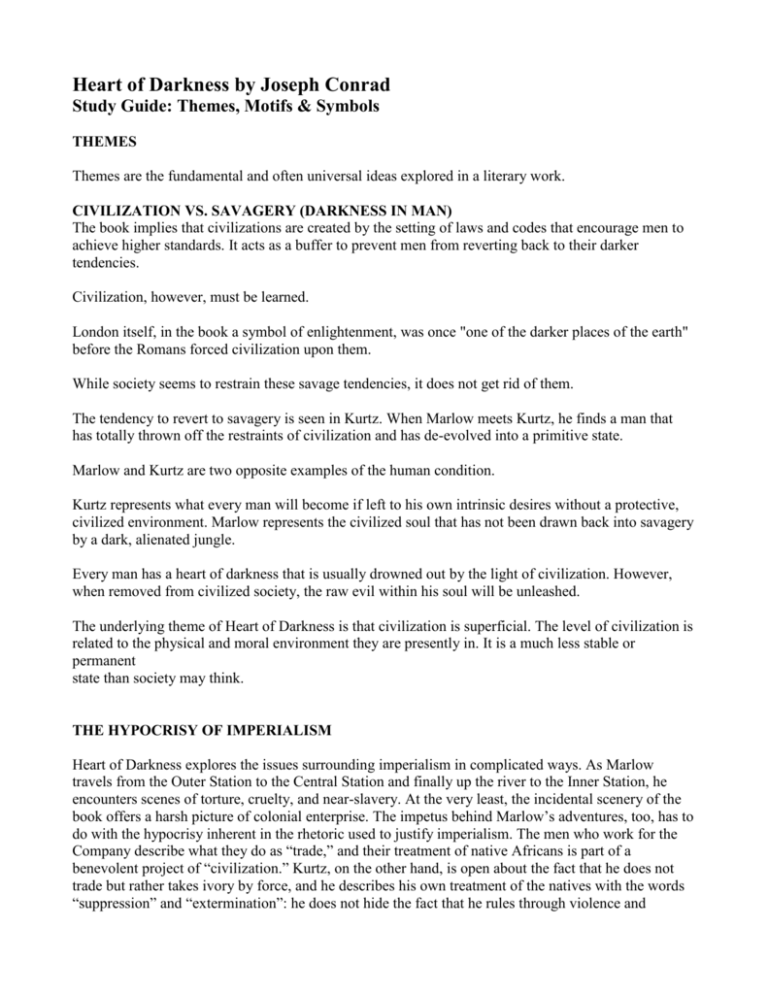
Heart of Darkness by Joseph Conrad Study Guide: Themes, Motifs & Symbols THEMES Themes are the fundamental and often universal ideas explored in a literary work. CIVILIZATION VS. SAVAGERY (DARKNESS IN MAN) The book implies that civilizations are created by the setting of laws and codes that encourage men to achieve higher standards. It acts as a buffer to prevent men from reverting back to their darker tendencies. Civilization, however, must be learned. London itself, in the book a symbol of enlightenment, was once "one of the darker places of the earth" before the Romans forced civilization upon them. While society seems to restrain these savage tendencies, it does not get rid of them. The tendency to revert to savagery is seen in Kurtz. When Marlow meets Kurtz, he finds a man that has totally thrown off the restraints of civilization and has de-evolved into a primitive state. Marlow and Kurtz are two opposite examples of the human condition. Kurtz represents what every man will become if left to his own intrinsic desires without a protective, civilized environment. Marlow represents the civilized soul that has not been drawn back into savagery by a dark, alienated jungle. Every man has a heart of darkness that is usually drowned out by the light of civilization. However, when removed from civilized society, the raw evil within his soul will be unleashed. The underlying theme of Heart of Darkness is that civilization is superficial. The level of civilization is related to the physical and moral environment they are presently in. It is a much less stable or permanent state than society may think. THE HYPOCRISY OF IMPERIALISM Heart of Darkness explores the issues surrounding imperialism in complicated ways. As Marlow travels from the Outer Station to the Central Station and finally up the river to the Inner Station, he encounters scenes of torture, cruelty, and near-slavery. At the very least, the incidental scenery of the book offers a harsh picture of colonial enterprise. The impetus behind Marlow’s adventures, too, has to do with the hypocrisy inherent in the rhetoric used to justify imperialism. The men who work for the Company describe what they do as “trade,” and their treatment of native Africans is part of a benevolent project of “civilization.” Kurtz, on the other hand, is open about the fact that he does not trade but rather takes ivory by force, and he describes his own treatment of the natives with the words “suppression” and “extermination”: he does not hide the fact that he rules through violence and intimidation. His perverse honesty leads to his downfall, as his success threatens to expose the evil practices behind European activity in Africa. However, for Marlow as much as for Kurtz or for the Company, Africans in this book are mostly objects: Marlow refers to his helmsman as a piece of machinery, and Kurtz’s African mistress is at best a piece of statuary. It can be argued that Heart of Darkness participates in an oppression of nonwhites that is much more sinister and much harder to remedy than the open abuses of Kurtz or the Company’s men. Africans become for Marlow a mere backdrop, a human screen against which he can play out his philosophical and existential struggles. Their existence and their exoticism enable his selfcontemplation.This kind of dehumanization is harder to identify than colonial violence or open racism. While Heart of Darkness offers a powerful condemnation of the hypocritical operations of imperialism, it also presents a set of issues surrounding race that is ultimately troubling. MADNESS AS A RESULT OF IMPERIALISM Madness is closely linked to imperialism in this book. Africa is responsible for mental disintegration as well as physical illness. Madness has two primary functions. First, it serves as an ironic device to engage the reader’s sympathies. Kurtz, Marlow is told from the beginning, is mad. However, as Marlow, and the reader, begin to form a more complete picture of Kurtz, it becomes apparent that his madness is only relative, that in the context of the Company insanity is difficult to define. Thus, both Marlow and the reader begin to sympathize with Kurtz and view the Company with suspicion. Madness also functions to establish the necessity of social fictions. Although social mores and explanatory justifications are shown throughout Heart of Darkness to be utterly false and even leading to evil, they are nevertheless necessary for both group harmony and individual security. Madness, in Heart of Darkness, is the result of being removed from one’s social context and allowed to be the sole arbiter of one’s own actions. Madness is thus linked not only to absolute power and a kind of moral genius but to man’s fundamental fallibility: Kurtz has no authority to whom he answers but himself, and this is more than any one man can bear. THE ABSURDITY OF EVIL This novella is, above all, an exploration of hypocrisy, ambiguity, and moral confusion. It explodes the idea of the proverbial choice between the lesser of two evils. As the idealistic Marlow is forced to align himself with either the hypocritical and malicious colonial bureaucracy or the openly malevolent, rule defyingKurtz, it becomes increasingly clear that to try to judge either alternative is an act of folly: how can moral standards or social values be relevant in judging evil? Is there such thing as insanity in a world that has already gone insane? The number of ridiculous situations Marlow witnesses act as reflections of the larger issue: at one station, for instance, he sees a man trying to carry water in a bucket with a large hole in it. At the Outer Station, he watches native laborers blast away at a hillside with no particular goal in mind. The absurd involves both insignificant silliness and life-or-death issues, often simultaneously. That the serious and the mundane are treated similarly suggests a profound moral confusion and a tremendous hypocrisy: it is terrifying that Kurtz’s homicidal megalomania and a leaky bucket provoke essentially the same reaction from Marlow. Much of Heart of Darkness is concerned with Marlow’s struggle to maintain his sense of morality as power conspiracies rage all around him and the mysterious figure of Kurtz piques his curiosity. Marlow’s desire to do good grows increasingly futile as he is plunged into a world where no absolute goodness exists and the best he can do is choose between a selection of nightmares. Eventually, we see that the characters become unable to distinguish between good and evil. Conrad illustrates this moral ambiguity with light and darkness imagery that often blends together, yet is imbued with an overall inevitably sinister shade. IMPERIALISM/COLONIZATION (BELGIAN COMPANY) CRUELTY OF MAN GREED EXPLOITATION OF PEOPLE Unlike most novels that focus only on the evils of colonialism, Heart of Darkness pays more attention to the damage that colonization does to the souls of white colonizers than it does to the physical death and devastation unleashed on the black natives. Madness is closely linked to imperialism in this book. Africa is responsible for mental disintegration as well as physical illness. When one becomes so far removed from society’s morals and restrictions, good and evil become relative terms. When these moral boundaries begin fading, Conrad suggests, man loses the sense of where he stands in the great moral struggle. THEME OF POWER Many of Marlow’s crew have ambitions of moving up the corporate ladder of the Company. Insatiable greed for wealth and power defines \their characters. This greed quickly demolishes any sense of morality they may hold and we find a handful of them attempting to get in Marlow’s good graces for the sake of his aunt’s influences. Kurtz’s ambitions do not stop at merely moving up in the Company; he desires to prove himself superior to all Africans. Even Marlow is sucked in; he tries obsessively to get as close to Kurtz as he can – both physically and emotionally. Marlow proves as attracted to power as any of his corrupt colleagues MOTIFS Motifs are recurring structures, contrasts, or literary devices that can help to develop and inform the text’s major themes. OBSERVATION AND EAVESDROPPING Marlow gains a great deal of information by watching the world around him and by overhearing others’ conversations, as when he listens from the deck of the wrecked steamer to the manager of the Central Station and his uncle discussing Kurtz and the Russian trader. This phenomenon speaks to the impossibility of direct communication between individuals: information must come as the result of chance observation and astute interpretation. Words themselves fail to capture meaning adequately, and thus they must be taken in the context of their utterance. Another good example of this is Marlow’s conversation with the brickmaker, during which Marlow is able to figure out a good deal more than simply what the man has to say. INTERIORS AND EXTERIORS Comparisons between interiors and exteriors pervade Heart of Darkness. As the narrator states at the beginning of the text, Marlow is more interested in surfaces, in the surrounding aura of a thing rather than in any hidden nugget of meaning deep within the thing itself. This inverts the usual hierarchy of meaning: normally one seeks the deep message or hidden truth. The priority placed on observation demonstrates that penetrating to the interior of an idea or a person is impossible in this world. Thus, Marlow is confronted with a series of exteriors and surfaces—the river’s banks, the forest walls around the station, Kurtz’s broad forehead—that he must interpret. These exteriors are all the material he is given, and they provide him with perhaps a more profound source of knowledge than any falsely constructed interior “kernel.” DARKNESS Darkness is important enough conceptually to be part of the book’s title. However, it is difficult to discern exactly what it might mean, given that absolutely everything in the book is cloaked in darkness. Africa, England, and Brussels are all described as gloomy and somehow dark, even if the sun is shining brightly. Darkness thus seems to operate metaphorically and existentially rather than specifically. Darkness is the inability to see: this may sound simple, but as a description of the human condition it has profound implications. Failing to see another human being means failing to understand that individual and failing to establish any sort of sympathetic communion with him or her. SYMBOLS Symbols are objects, characters, figures, or colors used to represent abstract ideas or concepts. FOG Fog is a sort of corollary to darkness. Fog not only obscures but distorts: it gives one just enough information to begin making decisions but no way to judge the accuracy of that information, which often ends up being wrong. Marlow’s steamer is caught in the fog, meaning that he has no idea where he’s going and no idea whether peril or open water lies ahead. THE “WHITED SEPULCHRE” The “whited sepulchre” is probably Brussels, where the Company’s headquarters are located. A sepulchre implies death and confinement, and indeed Europe is the origin of the colonial enterprises that bring death to white men and to their colonial subjects; it is also governed by a set of reified social principles that both enable cruelty, dehumanization, and evil and prohibit change. The phrase “whited sepulchre” comes from the biblical Book of Matthew. In the passage, Matthew describes “whited sepulchres” as something beautiful on the outside but containing horrors within (the bodies of the dead); thus, the image is appropriate for Brussels, given the hypocritical Belgian rhetoric about imperialism’s civilizing mission. (Belgian colonies, particularly the Congo, were notorious for the violence perpetuated against the natives.) WOMEN Both Kurtz’s Intended and his African mistress function as blank slates upon which the values and the wealth of their respective societies can be displayed. Marlow frequently claims that women are the keepers of naïve illusions; although this sounds condemnatory, such a role is in fact crucial, as these naïve illusions are at the root of the social fictions that justify economic enterprise and colonial expansion. In return, the women are the beneficiaries of much of the resulting wealth, and they become objects upon which men can display their own success and status. Both Marlow and Kurtz see women as symbolizing decency and purity. Women represent the potential for goodness in all humans, which is important to both men after having seen the heart of darkness and evil. Marlow frequently claims that women are the keepers of naïve illusions; which is a crucial role, as these naïve illusions are at the root of the social fictions that justify economic enterprise and colonial expansion. Women are the beneficiaries of much of the resulting wealth, and they become objects upon which men can display their own success and status. THE KNITTING WOMEN: The two women Marlow encounters when he arrives at the offices of the Company represent the mythological Fates who spin, measure, and cut the thread of life. It is in the offices of the Company that Marlow’s life is being measured out as he begins his journey into the heart of Africa. The two women are also knitting black wool, symbolizing how the black natives are being shaped by the colonials to meet the needs of the white world that controls them and the world that the native people live in. KURTZ’S PAINTING: The image in the painting resembles the figure of justice, but there seems to be very little justice in Africa. This image could also be another representation of Kurtz’s idealized vision of women who must be kept ignorant of the darkness that he sees in the world. The painting can also symbolize the embodiment of the colonizing powers who are bringing “light” into a savage land. The fact that the woman wears a somber expression symbolizes the evil that the colonizers perpetrate upon the native people. THE RIVER The Congo River is the key to Africa for Europeans. It allows them access to the center of the continent without having to physically cross it; in other words, it allows the white man to remain always separate or outside. Africa is thus reduced to a series of two-dimensional scenes that flash by Marlow’s steamer as he travels upriver. The river also seems to want to expel Europeans from Africa altogether: its current makes travel upriver slow and difficult, but the flow of water makes travel downriver, back toward “civilization,” rapid and seemingly inevitable. Marlow’s struggles with the river as he travels upstream toward Kurtz reflect his struggles to understand the situation in which he has found himself. The ease with which he journeys back downstream, on the other hand, mirrors his acquiescence to Kurtz and his “choice of nightmares.” THE ACCOUNTANT: The Company’s accountant is the physical manifestation of the ethics of the company. What is important to the accountant is that he defies his surroundings. His physical appearance is elegant and pristine in an environment that is filthy and chaotic. He goes on with his work no matter what is happening around him, including people dying.
